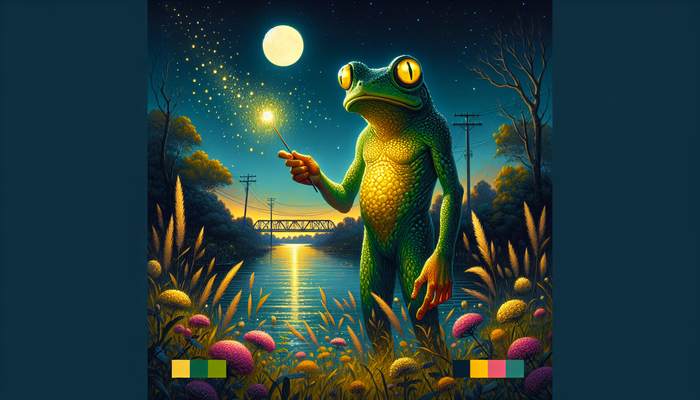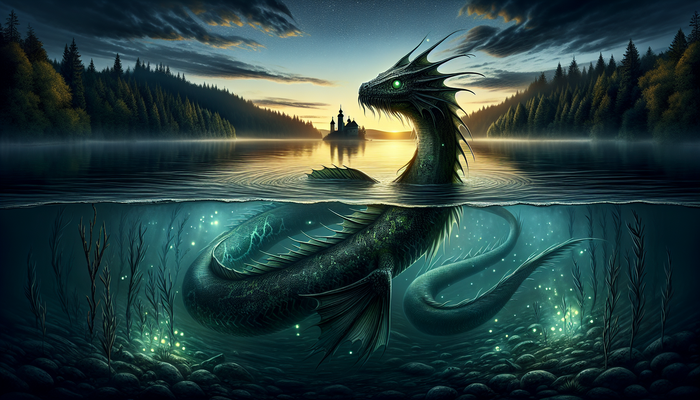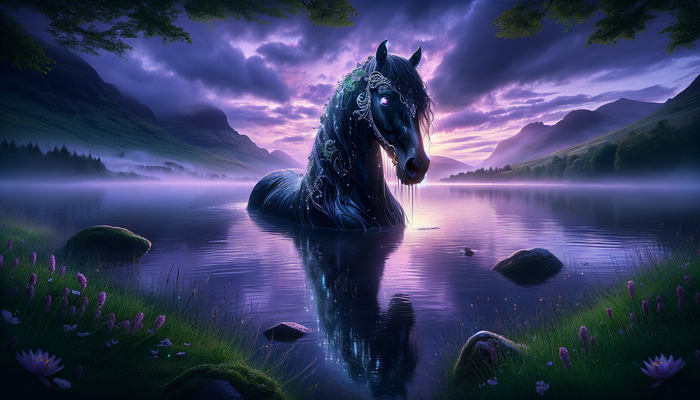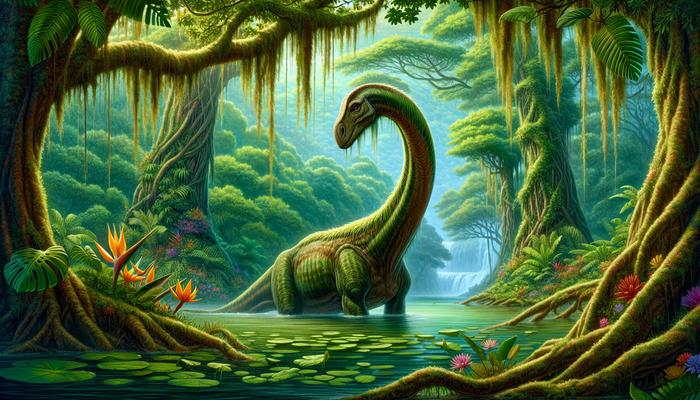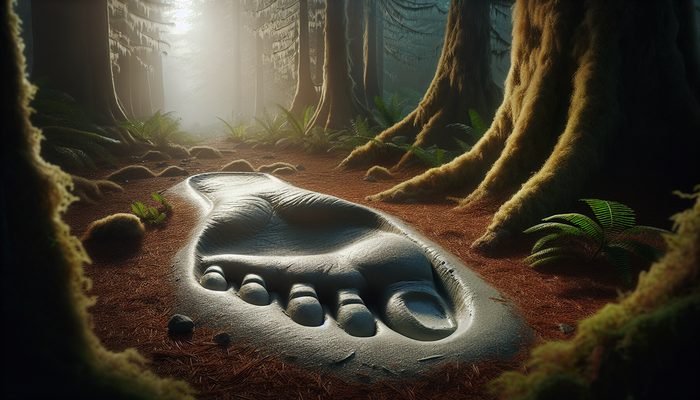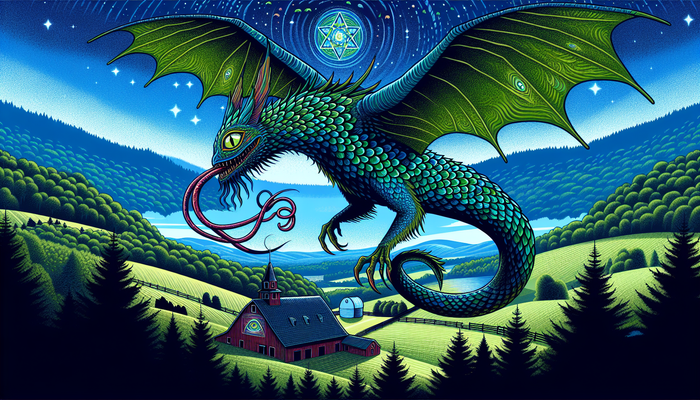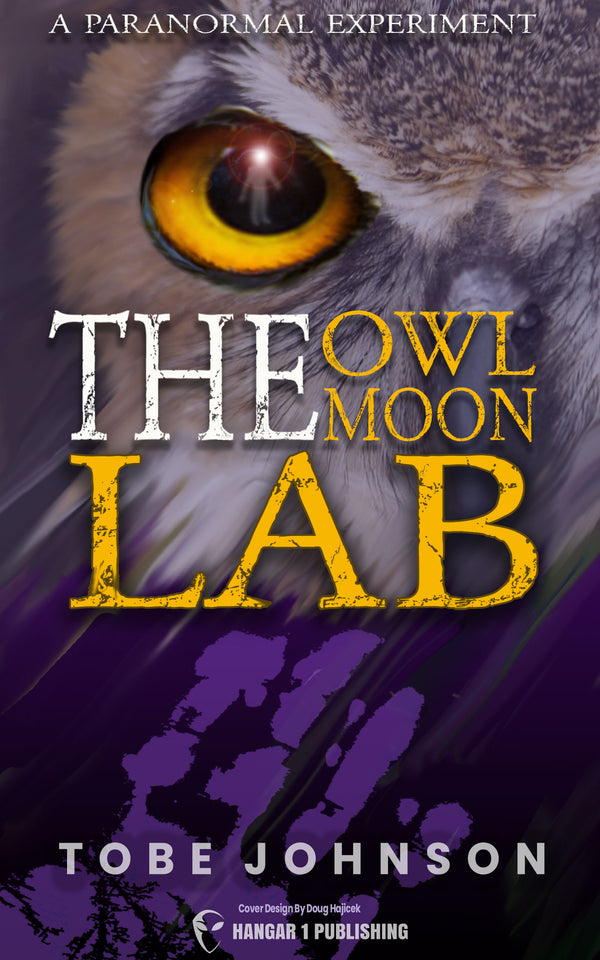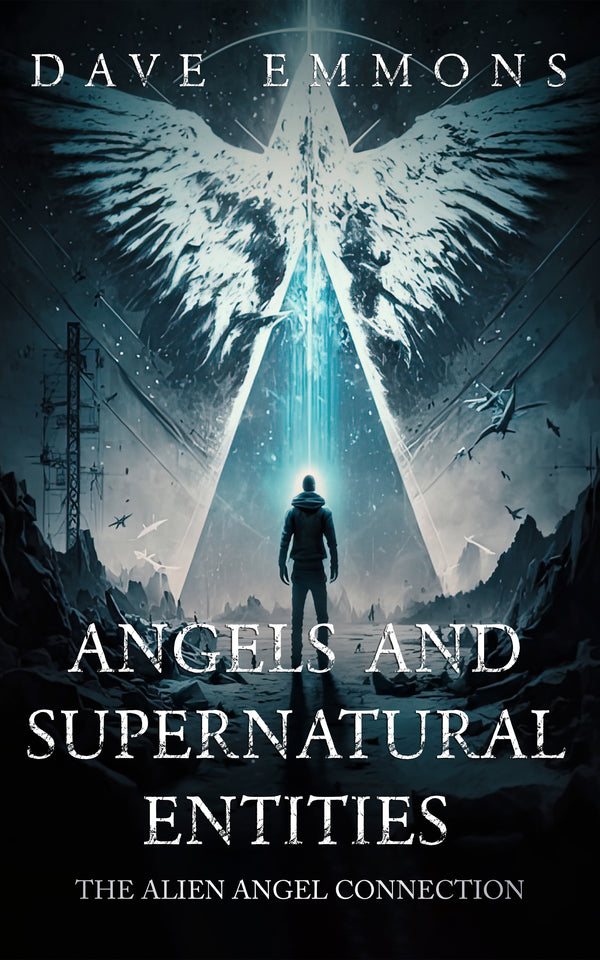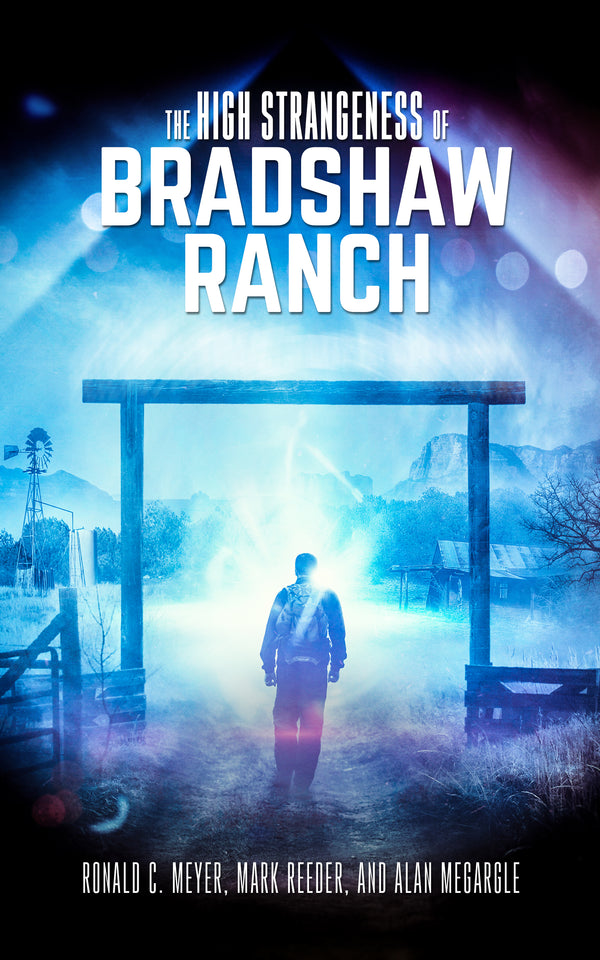The Fascinating World of Moose Cryptid Legends

By Lucas Jennings, Cryptozoologist
In the vast wilderness of North America, where towering pines cast long shadows and mist clings to hidden valleys, stories of extraordinary creatures have captivated the imagination for generations. Among these tales, one stands out with particular intrigue: the legend of the Specter Moose. This ghostly giant, said to roam the forests of Maine, represents just one facet of a rich tapestry of moose cryptid lore that has woven itself into the fabric of local culture and natural history.
Moose, those majestic denizens of the northern forests, already command respect and awe in their natural form. But what happens when the line between the ordinary and the extraordinary blurs? When a moose becomes something more – something that defies explanation and challenges our understanding of the natural world? This is the realm of moose cryptids, creatures that exist in the shadowy borderlands between fact and fiction, science and folklore.
The Specter Moose: A Phantom of the Forest
Picture this: It's 1891, and hunting guide Clarence Duffy is leading a group through the dense woods near Lobster Lake, Maine. The air is crisp, the forest quiet save for the occasional snap of a twig underfoot. Suddenly, through a gap in the trees, Duffy spots something that stops him dead in his tracks. There, standing in a clearing, is a moose unlike any he's ever seen. It's massive – easily twice the size of a normal bull – with a coat as white as fresh snow and antlers that seem to stretch impossibly wide.
This encounter marked the birth of the Specter Moose legend, a tale that would grow and evolve over the decades to come. Duffy's initial report was met with skepticism, of course. Who would believe in a moose that stood 10 to 15 feet tall at the shoulder, weighing in at a staggering 2,500 pounds? But as more sightings accumulated, the legend of the Specter Moose began to take on a life of its own.
The physical description of this cryptid is nothing short of awe-inspiring. Witnesses consistently report a creature of truly gargantuan proportions, dwarfing even the largest known moose specimens. Its coat is described as white or a very light gray, standing out starkly against the dark forest backdrop. But it's the antlers that truly capture the imagination – spanning 10 to 12 feet across, adorned with up to 22 points on each side. For comparison, a typical moose's antlers might span 4 to 6 feet with 8 to 12 points. The Specter Moose isn't just big; it's in a class all its own.
But size isn't the only thing that sets this creature apart. Reports often include details that venture into the realm of the supernatural. Hunters claim their bullets simply bounce off its hide, leaving the moose unharmed and often enraged. Some say it can vanish into thin air, while others describe a faint glow emanating from its fur, visible even on the darkest nights.
These attributes have led many to view the Specter Moose not just as an unusually large animal, but as something more – a spirit of the forest, perhaps, or a guardian of the wilderness. This perception has only deepened the creature's mystique and its hold on the local imagination.
Eyewitness Accounts: Face to Face with the Impossible
The story of the Specter Moose is built on a foundation of eyewitness accounts, each one adding new layers to the legend. Let's explore some of the most compelling sightings that have shaped this cryptid's reputation over the years.
Following Clarence Duffy's initial encounter in 1891, the floodgates of sightings seemed to open. In 1892, a New York sportsman named Howard Van Ness had a close encounter that would become one of the most famous in Specter Moose lore. Van Ness, an experienced hunter, spotted the creature while on an expedition about 30 miles northeast of Norcross, Maine. He described it as "weighing a ton, and as tall as a camel, with magnificent head and antlers."
What happened next has become the stuff of legend. Van Ness, confident in his marksmanship, took aim and fired. The bullet struck the moose just above the shoulder – a shot that should have brought down any normal animal. Instead, the Specter Moose let out a deep bellow, turned, and charged straight at Van Ness. The hunter barely had time to scramble beneath a tangle of fallen trees before the massive creature thundered past, circling the area at incredible speed before finally disappearing into the forest.
This encounter set the tone for many that would follow. Time and again, hunters reported similar experiences – shots that seemed to have no effect, followed by heart-stopping charges that left them shaken and questioning everything they thought they knew about the animals of the Maine woods.
As the 20th century dawned, sightings continued to accumulate. In 1901, a hunter from Boston reported seeing the beast near Chairback Mountain in the Katahdin region. Five years later, in 1906, a man named George Kneeland had a particularly hair-raising encounter while bicycling between Sherman and Macwahoc. Kneeland initially mistook the creature for a horse, but as he drew closer, he realized he was face to face with the legendary Specter Moose. The animal charged, forcing Kneeland to abandon his bicycle and scramble up a tree to safety.
These encounters share common themes that have become hallmarks of Specter Moose sightings. Witnesses consistently report a sense of awe and terror in the presence of the creature. Its size alone is enough to inspire fear, but it's the moose's apparent invulnerability and aggressive behavior that truly set it apart from its more mundane cousins.
Another recurring element in these stories is the moose's uncanny ability to evade capture or definitive proof of its existence. Despite numerous attempts by hunters and even organized expeditions, no one has ever managed to bring down a Specter Moose or capture clear photographic evidence. This elusiveness has only added to the creature's mystique, fueling speculation about its true nature and origins.
Perhaps most intriguingly, many sightings seem to be connected to moments of local significance or impending misfortune. This aspect of the legend reached a peak in the early 2000s when a sighting in Franklin, Maine, was reported shortly before a local restaurant burned down. Such occurrences have led some to view the Specter Moose as a harbinger of doom, adding a layer of foreboding to its already formidable reputation.
The Cultural Tapestry of the Specter Moose
The Specter Moose is more than just a creature of folklore; it has become deeply woven into the cultural fabric of Maine and the broader New England region. This ghostly giant serves as a powerful symbol of the wilderness – a reminder of the untamed spirit that still lurks in the shadows of the forest, defying our attempts to fully understand and control the natural world.
In many ways, the Specter Moose embodies the very essence of Maine itself. The state's rugged landscape, with its vast stretches of forest and remote lakes, provides the perfect backdrop for tales of mysterious creatures. The moose, already an iconic animal in Maine, takes on an almost mythic status in its spectral form. It represents the wild heart of the state, a connection to a time when the forests were deeper, darker, and filled with wonders and terrors in equal measure.
This symbolism has made the Specter Moose a source of local pride and identity. Even those who may not believe in its literal existence often embrace the legend as part of their cultural heritage. It's a story passed down through generations, told around campfires and in local gathering places, keeping alive a sense of mystery and wonder in an increasingly explained world.
The folklore surrounding the Specter Moose often casts it in the role of a harbinger – a creature whose appearance presages significant events, often of a dire nature. This aspect of the legend taps into a deep-seated human tendency to seek meaning and patterns in the natural world, especially in times of uncertainty or danger. The idea that a spectral moose might appear as a warning or a sign has become an integral part of the local storytelling tradition.
In some versions of the tale, the Specter Moose is seen as a protector of the forest, a spirit that appears to warn against over-hunting or environmental destruction. This interpretation has gained traction in recent years as concerns about conservation and the impact of human activity on wildlife habitats have grown. The legend has thus evolved to reflect changing attitudes and values, demonstrating the dynamic nature of folklore.
The Specter Moose has also left its mark on the world of art and commerce. Local artists have long been inspired by the creature, producing paintings, sculptures, and other works that capture its ethereal beauty and imposing presence. These artistic interpretations help to keep the legend alive, providing visual representations that fuel the imagination and spark curiosity.
In the realm of tourism and local business, the Specter Moose has become something of a cottage industry. T-shirts, postcards, and other souvenirs bearing stylized images of the creature are popular items in gift shops throughout Maine. Some local breweries have even named beers after the legendary moose, capitalizing on its notoriety and appeal.
This commercialization, while perhaps at odds with the wild nature of the legend, speaks to its enduring popularity and cultural significance. The Specter Moose has become a brand, a shorthand for the mystery and majesty of the Maine wilderness.
The legend has also inspired works of literature, from children's books to more serious explorations of local folklore. These stories often blend elements of the original sightings with new interpretations, keeping the legend fresh and relevant for new generations of readers.
In all these ways – as a symbol, a warning, an inspiration, and a brand – the Specter Moose has transcended its origins as a simple cryptid sighting to become a true cultural phenomenon. It represents the enduring power of folklore to shape our perceptions of the world around us and to connect us with the wild, untamed spaces that still exist on the fringes of our civilized world.
Unraveling the Mystery: Scientific Perspectives on the Specter Moose
While tales of the Specter Moose captivate the imagination, they also present a tantalizing challenge to the scientific community. How can we reconcile these extraordinary accounts with our understanding of moose biology and behavior? Several theories have been proposed, each attempting to explain at least some aspects of the Specter Moose phenomenon through the lens of natural science.
One of the most commonly cited explanations for the Specter Moose's unusual appearance is the possibility of albinism or leucism. Albinism is a genetic condition characterized by a complete lack of melanin, resulting in white fur and pink eyes. Leucism, on the other hand, is a partial loss of pigmentation that can result in white or pale coloration while retaining normal eye color.
Albino and leucistic moose, while rare, are not unheard of. In fact, a population of white moose in Ontario, Canada, has gained some fame in recent years. These animals, often referred to as "spirit moose" by local indigenous communities, demonstrate that white coloration in moose is indeed possible.
However, there are some issues with this explanation when applied to the Specter Moose. For one, true albino animals typically have pink or red eyes due to the lack of pigmentation. The Specter Moose, in contrast, is consistently described as having brown eyes. This detail aligns more closely with leucism, but even this doesn't fully account for the creature's reported size and supernatural attributes.
Another biological factor that might contribute to the Specter Moose legend is the impact of parasites, particularly winter ticks. Moose infested with large numbers of these ticks often experience significant hair loss, leading to a pale, ghostly appearance. In severe cases, this can result in a condition colloquially known as "ghost moose."
The effects of these parasites can be dramatic. Affected moose may appear gaunt and sickly, with patchy fur that gives them an otherworldly appearance. In the dim light of the forest, especially to an observer already primed by stories of spectral creatures, such an animal might indeed seem supernatural.
However, this explanation falls short when it comes to accounting for the Specter Moose's reported size and invulnerability. Moose suffering from severe tick infestations are typically weakened and underweight, not larger than normal.
Some researchers have proposed that the Specter Moose might represent an unknown subspecies of moose, perhaps a remnant population of a larger, Ice Age variant. While intriguing, this theory lacks supporting evidence in the fossil record and doesn't explain the creature's more fantastical attributes.
A more prosaic explanation suggests that the Specter Moose legend might result from a combination of misidentification, exaggeration, and the psychological effects of isolation in the wilderness. The human mind, especially when primed by stories of mysterious creatures, can play tricks on perception. A large bull moose, seen in poor lighting or at an odd angle, might appear much larger than it actually is. Add in the adrenaline rush of an unexpected encounter, and it's not hard to see how stories of an impossibly large, ghostly moose might take root.
This psychological aspect is particularly relevant when considering reports of the Specter Moose's invulnerability to bullets. In the heat of the moment, with adrenaline pumping, a hunter might genuinely believe they've made a perfect shot, only to see the animal run off unharmed. The mind, seeking to make sense of this unexpected outcome, might latch onto supernatural explanations.
It's also worth considering the role of storytelling and cultural transmission in shaping and perpetuating the Specter Moose legend. As tales are passed down and retold, details can be embellished, and separate incidents might be conflated into a single, more dramatic narrative. Over time, this process can transform a series of unusual but explainable encounters into a cohesive legend of a supernatural creature.
From a scientific perspective, the Specter Moose presents a fascinating case study in the intersection of biology, psychology, and folklore. While we may never fully explain every aspect of the legend, the pursuit itself offers valuable insights into both natural phenomena and human nature.
The challenge for scientists and researchers is to approach these stories with an open mind while maintaining rigorous standards of evidence. By carefully examining each element of the Specter Moose legend – from its reported physical characteristics to the circumstances of its sightings – we may uncover new insights into moose biology, wildlife behavior, and the complex ways in which humans interact with and interpret the natural world.
Ultimately, the scientific perspective on the Specter Moose serves not to debunk or diminish the legend, but to enrich our understanding of it. By exploring the possible natural explanations for these sightings, we gain a deeper appreciation for the complexity of the natural world and the enduring power of the human imagination.
Beyond the Specter: Other Moose Cryptids
While the Specter Moose of Maine may be the most famous moose cryptid, it's far from the only one. Across North America, various legends and sightings of unusual moose-like creatures have captured the public imagination. These stories, while less well-known than the Specter Moose, contribute to a rich tapestry of folklore and cryptozoology that spans the continent.
One such creature is the Moose Monster, reported primarily in northwestern and central Canada. Unlike the ghostly white Specter Moose, the Moose Monster is described as a more typical brown color, but on an vastly larger scale. Witnesses claim it stands between 2.4 to 4.1 meters tall at the shoulder – potentially twice the height of a normal moose.
Interestingly, the Moose Monster is generally described as being quite docile, unlike the often aggressive Specter Moose. Sightings typically involve the creature peacefully grazing or moving through the forest, its massive size being the primary factor that sets it apart from normal moose.
The origins of the Moose Monster legend are less clear than those of the Specter Moose, with sightings scattered across a wide geographic area and spanning several decades. Some cryptozoologists have speculated that it could represent a surviving population of Cervalces scotti, also known as the stag-moose – a prehistoric species that went extinct at the end of the last Ice Age. However, as with many cryptid theories, hard evidence remains elusive.
Another intriguing moose-adjacent cryptid is the "Not Deer," a creature reported primarily in the Appalachian region. While not strictly a moose, the Not Deer shares some characteristics with moose cryptids and is worth examining in this context.
The Not Deer is described as a deer-like creature that seems "off" in some fundamental way. Witnesses report seeing an animal that looks like a deer at first glance, but upon closer inspection reveals unsettling characteristics. These might include too many joints in its legs, an unusually human-like face, or movements that seem unnatural for a deer.
Some researchers have drawn parallels between Not Deer sightings and cases of chronic wasting disease (CWD) in deer populations. CWD is a fatal neurological illness that can cause unusual behavior and physical appearance in affected animals. However, many Not Deer reports include details that go beyond what could be explained by known diseases, venturing into more supernatural territory.
The connection between the Not Deer and moose cryptids like the Specter Moose lies in the way these legends reflect our complex relationship with familiar animals. Both stories take a well-known creature and twist it into something uncanny and unsettling, challenging our assumptions about the natural world.
Venturing into more whimsical territory, we find the Hugag, a creature from American folklore that bears some resemblance to a moose. Described in tall tales of lumberjacks and frontiersmen, the Hugag is said to have the general shape of a moose but with some crucial differences. Its legs are said to be jointless, forcing it to sleep leaning against a tree, and it possesses an upper lip so long that it must be held up with its antlers to prevent tripping.
While clearly more of a humorous invention than a serious cryptid, the Hugag represents another facet of moose-inspired folklore. It demonstrates how the moose's distinctive appearance has captured the human imagination, inspiring stories that range from the terrifying to the absurd.
These varied moose cryptids and legends, each with its own unique characteristics and cultural context, illustrate the diversity of cryptozoological lore. They also highlight how different regions and cultures interpret and mythologize the animals in their environment.
The Moose Monster of Canada, with its enormous size but peaceful demeanor, perhaps reflects the vast, untamed wilderness of the Canadian forests. The Not Deer of Appalachia, with its unsettling, almost-but-not-quite-deer appearance, might be seen as an embodiment of the complex and sometimes dark history of that region. And the Hugag, with its comical features, speaks to the tradition of tall tales and humorous exaggeration in American frontier folklore.
Together, these legends form a rich ecosystem of moose-inspired mythology. They demonstrate how a single animal – the moose – can inspire a wide range of stories and beliefs, each shaped by the specific cultural and environmental context in which it arises.
Moreover, these varied legends offer different lenses through which to examine our relationship with the natural world. Whether it's the awe and fear inspired by the Specter Moose, the wonder evoked by the Moose Monster, the unease triggered by the Not Deer, or the laughter prompted by the Hugag, each of these creatures reflects a different facet of human experience in the face of the wild.
In studying these diverse moose cryptids, we gain insight not just into the specific legends themselves, but into the broader patterns of how humans interpret and mythologize the natural world. We see how the lines between reality and fantasy can blur, how known animals can become the basis for unknown creatures, and how our fears, hopes, and sense of humor all play a role in shaping the stories we tell about the world around us.
The Specter Moose in the Digital Age
As we venture further into the 21st century, the legend of the Specter Moose has found new life in the digital realm. Social media platforms, online forums, and podcasts have become the modern-day equivalent of campfire stories, allowing tales of the ghostly moose to spread far beyond the forests of Maine.
This digital renaissance has brought both challenges and opportunities for the Specter Moose legend. On one hand, the internet has provided a platform for skeptics to challenge the veracity of sightings and offer alternative explanations. On the other, it has allowed believers and enthusiasts to connect, share experiences, and keep the legend alive in new and exciting ways.
One of the most significant impacts of the digital age on the Specter Moose legend has been the democratization of storytelling. In the past, tales of encounters with the creature might have been limited to local newspapers or word of mouth. Now, anyone with an internet connection can share their story with the world. This has led to a proliferation of Specter Moose content online, from detailed written accounts to shaky cell phone videos purporting to show glimpses of the elusive beast.
Social media platforms like Twitter and TikTok have been particularly influential in spreading awareness of the Specter Moose legend. Hashtags like #SpecterMoose and #MaineCryptids have become gathering points for enthusiasts to share stories, theories, and even artwork inspired by the creature. Short-form video platforms have given rise to a new genre of content, where users recreate supposed Specter Moose encounters or offer their own interpretations of what the creature might look like.
Podcasts, too, have played a significant role in keeping the Specter Moose in the public consciousness. Shows dedicated to cryptozoology and unexplained phenomena frequently feature episodes on the ghostly moose, often bringing in local experts or eyewitnesses to share their perspectives. These long-form audio discussions allow for a deeper exploration of the legend than might be possible in other formats, delving into the historical context, scientific theories, and cultural significance of the Specter Moose.
The internet has also facilitated the growth of online communities dedicated to tracking and studying the Specter Moose. Forums and Facebook groups serve as hubs for enthusiasts to discuss recent sightings, debate theories, and organize expeditions to search for evidence of the creature's existence. These communities have developed their own cultures and hierarchies, with certain members gaining reputations as experts or respected researchers within the Specter Moose subculture.
However, the digital age has also brought new challenges to the Specter Moose legend. The ease with which images and videos can be manipulated has led to a proliferation of hoaxes and fake sightings. This has made it increasingly difficult for researchers and enthusiasts to separate genuine accounts from deliberate fabrications, potentially undermining the credibility of the legend as a whole.
Additionally, the global reach of the internet has exposed the Specter Moose legend to a wider audience, leading to cross-pollination with other cryptid stories from around the world. While this has enriched the lore in many ways, it has also led to some dilution of the specifically local character of the original legend.
Despite these challenges, the digital age has undoubtedly breathed new life into the Specter Moose legend. Online resources have made it easier than ever for people to research the history of sightings, access scientific discussions about the possibility of unknown large animals, and connect with others who share their fascination with this enigmatic creature.
The Specter Moose has also found its way into digital media beyond social platforms. Online games featuring cryptid hunts often include the ghostly moose as a prized target, while digital artists have produced stunning renderings of the creature that capture its majestic and otherworldly qualities. These digital representations help to keep the legend vivid and engaging for new generations of enthusiasts.
Perhaps most importantly, the digital age has allowed for a more nuanced and multifaceted approach to the Specter Moose legend. Online discussions often blend scientific skepticism with open-minded speculation, creating a space where the boundaries between fact and folklore can be explored in depth. This approach reflects a growing understanding that legends like the Specter Moose have value beyond their literal truth – they serve as windows into our cultural psyche, our relationship with the natural world, and our enduring capacity for wonder and imagination.
As we look to the future, it seems clear that the legend of the Specter Moose will continue to evolve and adapt to new technologies and modes of storytelling. Virtual and augmented reality may soon allow people to "encounter" the Specter Moose in immersive digital environments, while advances in environmental DNA testing and camera trap technology could provide new avenues for scientific investigation of unusual wildlife sightings.
Whatever form it takes, the story of the Specter Moose seems likely to endure, a testament to our enduring fascination with the mysteries of the natural world and the power of a good story to capture our collective imagination.
The Enduring Legacy of the Specter Moose
As we've journeyed through the misty forests of Maine and beyond, exploring the legend of the Specter Moose and its cryptid kin, we've uncovered a rich tapestry of folklore, science, and cultural significance. This ghostly giant, with its imposing stature and otherworldly attributes, has left an indelible mark on the landscape of American cryptozoology and regional folklore.
The Specter Moose represents more than just a mysterious animal or a tall tale. It embodies our complex relationship with the wilderness – our awe at its majesty, our fear of its unknown depths, and our hope that there are still wonders waiting to be discovered. In an age where satellite imagery and GPS have mapped every corner of the globe, the Specter Moose reminds us that mystery and wonder can still exist in the world around us.
Moreover, the evolution of the Specter Moose legend over time reflects broader cultural shifts in our society. From its origins as a terrifying forest spirit to its modern incarnation as a subject of scientific inquiry and digital storytelling, the Specter Moose has adapted to changing times while retaining its essential air of mystery.
The scientific investigations into the Specter Moose, while yet to provide definitive proof of its existence, have nonetheless contributed valuable insights into moose biology, wildlife behavior, and the psychology of eyewitness accounts. These studies serve as a reminder of the importance of approaching even the most fantastic claims with an open and inquiring mind.
As we've seen, the Specter Moose is not alone in the pantheon of moose cryptids. From the towering Moose Monster of Canada to the unsettling Not Deer of Appalachia, these legends form a diverse ecosystem of folklore that speaks to the enduring power of the moose as a symbol of the wild. Each of these creatures, in its own way, challenges our understanding of the natural world and invites us to look at familiar animals with fresh eyes.
In the digital age, the Specter Moose has found new life and new audiences. Online communities have become the modern equivalent of folklore traditions, passing down stories and sightings to a global audience. While this digital renaissance brings its own challenges, it also ensures that the legend will continue to evolve and captivate new generations of enthusiasts.
Perhaps the most significant aspect of the Specter Moose legend is its ability to inspire. It encourages us to look more closely at the world around us, to question what we think we know, and to maintain a sense of wonder about the possibilities that might lurk just beyond our understanding. Whether viewed as a literal creature waiting to be discovered or as a powerful symbol of the untamed wilderness, the Specter Moose invites us to step outside our comfort zones and explore the unknown.
As we close this exploration of the Specter Moose and its cryptid cousins, we're left with more questions than answers – and that's exactly as it should be. The true value of these legends lies not in their ultimate verifiability, but in their ability to spark curiosity, fuel imagination, and remind us of the enduring mystery and majesty of the natural world.
So the next time you find yourself in a misty forest, with shadows playing tricks on your eyes and the rustle of unseen creatures in the underbrush, take a moment to wonder: could that massive shape in the distance be more than just a normal moose? Could it be the legendary Specter Moose, still roaming the wilderness, a living embodiment of nature's endless capacity to surprise and amaze us? The answer, like the creature itself, remains elusive – and that's what makes the legend of the Specter Moose so enduringly fascinating.
From Bigfoot to UFOs: Hangar 1 Publishing Has You Covered!
Explore Untold Stories: Venture into the world of UFOs, cryptids, Bigfoot, and beyond. Every story is a journey into the extraordinary.
Immersive Book Technology: Experience real videos, sights, and sounds within our books. Its not just reading; its an adventure.


